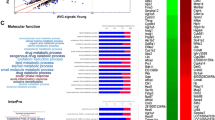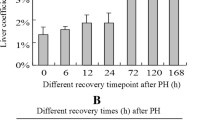Abstract
In this study, 55 of the organic acid metabolism-involved genes were primarily confirmed to be associated with liver regeneration (LR) by bioinformatics and gene expression profiling analysis. Number of the initially and totally expressed genes occurring in initiation phase of LR, G0/G1, cell proliferation, cell differentiation and liver tissue structure-function reconstruction were 21, 5, 33, 1 and 40, 20, 174, 44, respectively, illustrating that genes were initially expressed mainly in initiation stage, and worked in different phases. 151 times up-regulation and 114 times down-regulation as well as 14 types of expression patterns showed the diversification and complication of genes expression changes. It is inferred from the above gene expression changes and patterns that acetate biosynthesis enhanced at forepart, propionate biosynthesis at forepart, prophase and early metaphase, pyruvate biosynthesis at forepart, metaphase and anaphase, succinate biosynthesis at forepart and anaphase; malate biosynthesis in metaphase and N-acetylneuraminate biosynthesis at 36, 66 and 96 h. Whereas, carnitine biosynthsis attenuates at forepart and prophase, enhancement at middle metaphase; isocitrate in the forepart, quinolinate at forepart and early metaphase, creatine at early metaphase and fumarate at anaphase perform the restrained biosynthesis, respectively; catabolisms of propionate and pyruvate were depressed in metaphase.


Similar content being viewed by others
Abbreviations
- LR:
-
Liver regeneration
- PH:
-
Partial hepatectomy
- SO:
-
Sham operation
References
Alberati-Giani D, Buchli R, Malherbe P, Broger C, Lang G, Kohler C, Lahm HW, Cesura AM (1996) Isolation and expression of a cDNA clone encoding human kynureninase. Eur J Biochem 239:460–468
Arkin A, Ross J, McAdams HH (1998) Stochastic kinetic analysis of developmental pathway bifurcation in phage lambda-infected Escherichia coli cells. Genetics 149:1633–1648
Braissant O, Henry H, Villard AM, Speer O, Wallimann T, Bachmann C (2005) Creatine synthesis and transport during rat embryogenesis: spatiotemporal expression of AGAT, GAMT and CT1. BMC Dev Biol 5:9
Cai YD, Chou KC (2005) Using functional domain composition to predict enzyme family classes. J Proteome Res 4:101–111
Chou KC (2004) Molecular therapeutic target for type-2 diabetes. J Proteome Res 3:1284–1288
Chou KC (2005) Using amphiphilic pseudo amino acid composition to predict enzyme subfamily classes. Bioinformatics 21:10–19
Chou KC, Cai YD, Zhong WZ (2006) Predicting networking couples for metabolic pathways of Arabidopsis. EXCLI J 5:55–65
Chow KM, Ma Z, Cai J, Pierce WM, Hersh LB (2005) Nardilysin facilitates complex formation between mitochondrial malate dehydrogenase and citrate synthase. Biochim Biophys Acta 1723:292–301
Coustou V, Biran M, Besteiro S, Riviere L, Baltz T, Franconi JM, Bringaud F (2006) Fumarate is an essential intermediary metabolite produced by the procyclic trypanosoma brucei. J Biol Chem 281:26832–26846
Collins JF (2006) Gene chip analyses reveal differential genetic responses to iron deficiency in rat duodenum and jejunum. Biol Res 39:25–37
Dransfeld O, Gehrmann T, Kohrer K, Kircheis G, Holneicher C, Haussinger D, Wettstein M (2005) Oligonucleotide microarray analysis of differential transporter regulation in the regenerating rat liver. Liver Int 25:1243–1258
Eisen MB, Spellman PT, Brown PO, Botstein D (1998) Cluster analysis and display of genome-wide expression patterns. Proc Natl Acad Sci 95:14863–14868
Fausto N, Campbell JS, Riehle KJ (2006) Mechanisms of liver regeneration and their clinical implications. Hepatol 43:45–53
Higgins GM, Anderson RM (1931) Experimental pathology of the liver: restoration of the liver of the white rat following partial surgical removal. J Arch Pathol 12:186–222
Ito M, Ogawa K, Takeuchi K, Nakada A, Heishi M, Suto H, Mitsuishi K, Sugita Y, Ogawa H, Ra C (2004) Gene expression of enzymes for tryptophan degradation pathway is upregulated in the skin lesions of patients with atopic dermatitis or psoriasis. J Dermatol Sci 36:157–164
Jitrapakdee S, Booker GW, Cassady AI, Wallace JC (1996) Cloning, sequencing and expression of rat liver pyruvate carboxylase. Biochem J 316:631–637
Knepp JH, Geahr MA, Forman MS, Valsamakis A (2003) Comparison of automated and manual nucleic acid extraction methods for detection of enterovirus RNA. J Clin Microbiol 41:3532–3536
Kolker S, Koeller DM, Sauer S, Horster F, Schwab MA, Hoffmann GF, Ullrich K, Okun JG (2004) Excitotoxicity and bioenergetics in glutaryl-CoA dehydrogenase deficiency. J Inherit Metab Dis 27:805–812
Lai HS, Chen Y, Chen WJ (1998) Carnitine contents in remnant liver, kidney, and skeletal muscle after partial hepatectomy in rats: randomized trial. World J Surg 22:42–47
Li L, Roden J, Shapiro BE, Wold BJ, Bhatia S, Forman SJ, Bhatia R (2005) Reproducibility, fidelity, and discriminant validity of mRNA amplification for microarray analysis from primary hematopoietic cells. J Mol Diagn 7:48–56
Mehta AK, Gould GG, Gupta M, Carter LP, Gibson KM, Ticku MK (2006) Succinate semialdehyde dehydrogenase deficiency does not down-regulate gamma-hydroxybutyric acid binding sites in the mouse brain. Mol Genet Metab 88:86–89
Michalopoulos GK, DeFrances M (2005) Liver regeneration. Adv Biochem Eng Biotechnol 93:101–134
Namboodiri MA, Corigliano-Murphy A, Jiang G, Rollag M, Provencio I (2000) Murine aspartoacylase: cloning, expression and comparison with the human enzyme. Brain Res Mol Brain Res 77:285–289
Nuyts S, Van Mellaert L, Lambin P, Anne J (2001) Efficient isolation of total RNA from clostridium without DNA contamination. J Microbiol Methods 44:235–238
Pahlavan PS, Feldmann RE Jr, Zavos C, Kountouras J (2006) Prometheus’ challenge: molecular, cellular and systemic aspects of liver regeneration. J Surg Res 134:238–251
Shen HB, Chou KC (2007) EzyPred: a top-down approach for predicting enzyme functional classes and subclasses. Biochem Biophys Res Comm 364:53–59
Shen W, Willis D, Zhang Y, Schlattner U, Wallimann T, Molloy GR (2002) Expression of creatine kinase isoenzyme genes during postnatal development of rat brain cerebellum: evidence for transcriptional regulation. Biochem J 367:369–380
Tanner ME (2005) The enzymes of sialic acid biosynthesis. Bioorg Chem 33:216–228
Tsuji S, Qureshi MA, Hou EW, Fitch WM, Li SS (1994) Evolutionary relationships of lactate dehydrogenases (LDHs) from mammals, birds, an amphibian, fish, barley, and bacteria. Proc Natl Acad Sci USA 91:9392–9396
Varadkar S, Surtees R (2004) Glutaric aciduria type I and kynurenine pathway metabolites: a modified hypothesis. J Inherit Metab Dis 27:835–842
Wang H, Chu W, Das SK, Ren Q, Hasstedt SJ, Elbein SC (2002) Liver pyruvate kinase polymorphisms are associated with type 2 diabetes in northern European Caucasians. Diabetes 51:2861–2865
Werner T (2001) Cluster analysis and promoter modelling as bioinformatics tools for the identification of target genes from expression array data. Pharmacogenomics 2:25–36
Xu CS, Zhao LF, Yang KJ, Zhang JB (2004) The origin and the function of liver stem cell. Acta Biologiae Exp Sinica 37:72–77
Xu CS, Chang CF, Yuan JY, Li WQ, Han HP, Yang KJ, Zhao LF, Li YC, Zhang HY, Rahman S, Zhang JB (2005) Expressed genes in regenerating rat liver after partial hepatectomy. World J Gastroenterol 11:2932–2940
Xu CS, Chang CF (2007) Expression profiles of the genes associated with metabolism and transport of amino acids and their derivatives in rat liver regeneration. Amino acids. doi:10.1007/s00726-00007-00576-00722
Yue H, Eastman PS, Wang BB, Minor J, Doctolero MH, Nuttall RL, Stack R, Becker JW, Montgomery JR, Vainer M, Johnston R (2001) An evaluation of the performance of cDNA microarrays for detecting changes in global mRNA expression. Nucleic Acids Res 29:41–51
Zhang CT, Chou KC (1993) Graphic analysis of codon usage strategy in 1490 human proteins. J Protein Chem 12:329–335
Zhang CT, Chou KC (1994) Analysis of codon usage in 1562 E. Coli protein coding sequences. J Mol Biol 238:1–8
Zhang CT, Chou KC (1996) An analysis of base frequencies in the anti-sense strands corresponding to the 180 human protein coding sequences. Amino Acids 10:253–262
Zhang S, Kim KH (1996) Acetyl-coA carboxylase is essential for nutrient-induced insulin secretion. Biochem Biophys Res Commun 229:701–705
Acknowledgment
We acknowledge funding supported from the State Key Development Program for Basic Research of China: Gene expression profiles and action analysis of the isolated rat regenerating liver cells (No. 2006CB708506).
Author information
Authors and Affiliations
Corresponding author
Rights and permissions
About this article
Cite this article
Guo, G.B., Xu, C.S. Expression profiles of the organic acid metabolism-associated genes during rat liver regeneration. Amino Acids 34, 597–604 (2008). https://doi.org/10.1007/s00726-007-0013-6
Received:
Accepted:
Published:
Issue Date:
DOI: https://doi.org/10.1007/s00726-007-0013-6




